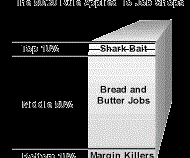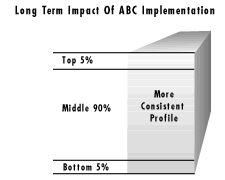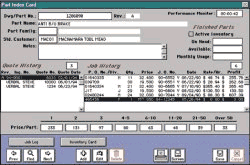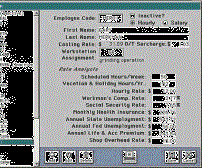The ABCs Of Activities Based Costing
A lot of job shops still use a flat shop rate when costing, estimating or quoting. This job shop developed its own software following another approach that is almost as simple but more accurate.
Share




It costs money to run a shop. And running a job for a customer costs money, too. Nobody would argue with those two facts. Where it gets tricky is linking the cost of running a shop with the cost of running each job.
Making this link is important because what a shop charges its customers for a job has to include not only the costs directly related to that job but also some of the overall costs that are part of running a shop. If all of these costs aren't divvied up properly, the shop will end up either charging some customers too much or others not enough (or both). Charging too much will cause a shop to lose customers; charging too little will cause a shop to lose money.
Like all shops, Starn Tool & Manufacturing in Meadville, Pennsylvania, has had to deal with this situation. About 10 years ago, this shop began switching from one method of costing to another and the result has made a tremendous difference, says Bill Starn, the president and owner of the company. "We used to use a flat shop-rate approach but now we use a concept called activities based costing," he says. "This method gives us a better picture of what our job costs really are and helps us make better decisions about the business. I know it's helped us become more profitable and grow in the right directions," he claims.
In fact, the shop has developed its own personal computer software to automate the process of tracking costs and divvying them up to various jobs. Starn Tool & Manufacturing has been using this software for many years, sharing it with only a few other shops in the area. Comments and suggestions from all of these users have been incorporated as enhancements in the latest version. Now this software is being made available nationwide as a commercial software product. But whether or not other shops purchase this software, Mr. Starn believes that the underlying costing concepts deserve a close look by all kinds of shops, especially small- to medium-sized job shops.
Flat-Rate Gone Flat
Starn Tool & Manufacturing was founded in 1945 and for more than forty years, the shop used the traditional "flat shop-rate" approach to job costing and quoting. Basically this approach adds an average hourly labor cost to an average hourly cost of running the business plus a percentage markup, then multiplies that cost times the hours a job is estimated to take. The figure that results is what is quoted to the customer. There are many ways of doing this kind of averaging, some more complex than others depending on the size and sophistication of the shop, but all more or less rely on averaging that lumps many costs together.
Of course, costs vary from job to job and from situation to situation. With the flat-rate approach, averaging evens out things that have gone up and down in the past so that a prediction can be made about the future. It assumes that the same ups and downs are likely to continue. It also takes the gamble that the ups and downs will cancel each other out over time, making the predictions reasonably accurate in the long run. In other words, the times that actual costs are lower than average will make up for the times that actual costs are higher than average. Most of the time, however, results will be as expected and a fair and adequate profit can be assured by applying the same markup to estimated costs.
Bill Starn watched his father before him run the company based on this kind of averaging. Working his way through the shop as he grew up, the younger Mr. Starn could see firsthand how inaccurate this system was, a poor reflection of what was happening on the shop floor. This approach frequently disguised losses or allowed for missed profit opportunities. Later, after he took over the company, Mr. Starn began implementing what he believed would be a better way to get the information he needed to make more educated decisions about the business.
"The big problem with flat-rate systems," explains Mr. Starn, "is that they make some jobs look like losers when they aren't and some jobs look like winners when they aren't. This happens because a flat shop rate doesn't—and can't—take into account the important differences between related costs and activities."
Mr. Starn uses the diagram in Figure 1 (below) to make this point. He says that on average, flat-rate costing will be about right for only 80 percent of the jobs to which it is applied. These are the "bread and butter" jobs that a shop hopes to thrive on. Unfortunately, 20 percent of the jobs that a shop quotes on using a flat shop rate will be costed too high ("shark bait" to be snatched away by aggressive competitors who are using more accurate cost estimates) or costed too low ("margin killers" that lose money and pull down the shop's overall profitability).
"Years ago, the 80/20 rule was good enough, but as job shops like ours took on more complex work using more sophisticated equipment in a more competitive environment, the stakes became higher. There's less room in today's world for the inevitable errors involved with a flat-rate approach," says Mr. Starn. "Variations in costs do not cancel each other out over time as we could once assume. In fact, even small differences in cost factors that tend to be overlooked can have a significant impact. However, a carefully implemented ABC system identifies these differences and shows the results." Table I (below) puts this point into view.
Starn Tool & Manufacturing is typically an untypical job shop. Started as a precision contract machining company, it now offers a wide range of services in the fields of precision machining and contract tooling. "We handle everything from precision machining, tool and die, spare parts tooling, fixtures, molds, and gages, to complex assemblies. Our common dimensional tolerance is 0.0001 inch and we're set up to handle orders ranging from larger production runs to one-off precision machined parts," states Jim Dinger, Starn's director of marketing. In addition, the company has a product line of "Tool Room Time Savers" such as compound sine bars, grinding wheel dressers and indicator bases, which are marketed to companies within the industry.
"The departments within the company are so different that a flat shop rate would obviously not work," Mr. Starn observes, "but even within departments, operations and activities are so different that each department has a different cost structure." According to Mr. Starn, this situation is an ideal application for the flexibility of ABC. "In fact, it's the only way we could get a handle on our costs and make sure that we're really making money on all of these projects," he says.
What Is Activities Based Costing?
In essence, ABC is a way to link costs with activities and link activities with the jobs or products that caused the activities. That way, all costs are divvied up and directed to the appropriate job or product, not just the costs that are obvious or easy to link. By linking activities with jobs or products, the cost of these activities can be more precisely allocated to the appropriate jobs or products.
The beauty of ABC is that it gives shop managers a way to link costs that are not easily or obviously related to jobs, and to make meaningful distinctions that reflect the significant differences between jobs or products.
ABC is not the same as cost accounting, although some cost accounting systems are built around the concepts of ABC. ABC is not the same as estimating or quoting, although ABC provides information that makes estimating and quoting more precise and reliable. ABC is not a shop control system, although ABC may help a shop understand what it really needs to control and what it doesn't.
The underlying concept of ABC is that the jobs, services, or products provided by a shop create activities and those activities create costs. All of the costs not directly attributable to these jobs, services or products must be associated with the activities that make them necessary. Then each activity's accumulated costs must be associated with the jobs, services or products that make them necessary and then the accumulated costs must be distributed among the jobs by some logical basis—a formula or rate.
By making shop managers think about activities in relation to costs instead of just thinking about jobs in relation to costs, ABC allows a truer, more complete picture of costs to emerge. The cause-and-effect relationship of costs and jobs becomes clearer. For example, when it becomes obvious that a certain kind of job causes activities that the shop ultimately must pay for, the shop can develop some kind of formula for directing an appropriate portion of that activity's cost to that kind of job. The formula usually breaks down the accumulated costs of that activity (what that activity cost for a whole year, for the whole plant, for all employees and so on) according to some statistical basis to be applied as a rate—per incident, by the square foot of plant space, per worker, and so on.
Implementing ABC
The way ABC works can be seen best by looking at some examples drawn from Starn Tool & Manufacturing's own experiences with it.
"When we started to move toward activities based costing," Mr. Starn recalls, "some of our discoveries were startling. The best example involved our second biggest customer, a nationally recognized company we had been working with for years. A more complete picture of our costs revealed that most of the jobs we did for them were at a very slim profit margin and more than a few actually lost money."
Initially, he reports, efforts were made to restructure pricing for this customer to a more realistic and sustainable level, but the efforts met strong resistance. "We had to decide whether we really wanted to keep this business and after some soul-searching, we eventually dropped them."
Reflecting on this incident, Tim Mullen, vice president of administration, notes, "The work for this customer was difficult, involving some of our most precise machines and our most skilled operators. These jobs were naturally at the high end of our costs but the flat rate we had been quoting was based on average costs. That might have been okay if this customer didn't account for an above average percentage of our sales. In this case, the law of averages was working against us." Mr. Mullen also notes that averaging tends to produce quotes that consistently attract the higher cost work because those jobs benefit from the built-in discount created by averaging.
Mr. Starn believes that ABC is most likely to be an eye-opener when it comes to direct labor rates. "In our shop, we still find it remarkable what a difference the cost of benefits, paid vacations, insurance, overtime and other variables make in one worker's hourly rate versus another even though the hourly wage for both employees is the same," he says.
ABC helps the shop make better utilization of its equipment. It helps protect the organization against mistakes based on what seems like common sense. "One of the early lessons we learned was from a job we had that at first seemed like a good candidate for a CNC machining center," Mr. Starn recalls. "The part had a number of holes to be drilled, in addition to milling and profiling. Conventional wisdom would say that drilling operations would be very efficient and economical if incorporated into the part program, but our cost analysis proved otherwise," he says. Moving the drilling operations to a manual drill press with a lower skilled operator proved to be much more profitable, even though a special drilling jig had to be designed and machined for this job. "Just because CNC is obviously more efficient doesn't mean it's necessarily more economical," Mr. Starn says, summing up.
In general, Mr. Starn attributes these benefits to ABC: "We've doubled our company's profit margin compared to our results in the 1970s and 80s, when we were starting to switch our costing philosophy. By paying attention to all of the costs of all our activities, we've learned what work we're comfortable with and what we're most competitive at. Those are the jobs we try to concentrate on in our quoting activity," he says.
"That doesn't mean we can't pick and choose some jobs that will stretch our skills or grow our expertise, but we won't be fooling ourselves about the cost of this on-the-job training," notes Mr. Starn. He adds, "At the same time, we also see the value of jobs that will fill our machines, because high utilization helps drive down our costs."
According to Mr. Starn, Starn Tool & Manufacturing is more successful in quoting, as it wins more of the quote requests it responds to. "We bid on the jobs we know we can handle and are confident that we can make money at. It's simply less of a guessing game," he says. Mr. Starn believes that almost every shop can achieve a 90 percent success rate on quoting accuracy with a carefully implemented ABC system. See Figure 2 (above, right).
Better Decisions
What types of equipment to buy is also influenced by ABC, both at the low end and the high end of technology. "Activities based costing helps us avoid buying a machine too expensive for the work, on one hand. On the other, it helps us avoid squandering expensive machines on work not priced to support it," says Mr. Starn.
Because Starn Tool & Manufacturing is involved in such a wide variety of work, its departments tend to be structured differently, with cost structures that vary likewise. ABC not only identifies and accommodates these differences, it capitalizes on them. Starn Tool's wire EDM department is a good example. Although it occupies a relatively small part of the building, that space is air conditioned, has special plumbing for chillers, has its own power conditioners on electrical lines, and other unique features that make its overhead costs significantly different from those of other departments. Its tooling costs (which include plain and premium EDM wire, dielectric fluids, filter cartridges and disposal charges), are higher than those of, say, the milling department. Labor rates are figured on a different basis, too.
"Our wire machines run in the untended mode much of the time," explains Mr. Starn, "and that has an effect on labor charged against a job. However, setup takes longer and requires more skill, so we factor that in separately, too."
In short, ABC lets Starn Tool's management make sure each department is earning its own keep and fully exploiting its own earning potential.
Software For ABC
Like many job shops, Starn Tool & Manufacturing had developed a manual system that implemented the core concepts of ABC. The system involved a lot of record keeping functions like those that were being computerized on personal computers in the 1980s. Mr. Starn asked a local software developer to look at his ABC system and see how it could be turned into software. By 1989, a prototype of the system was being tested in house. The results were very encouraging.
"From the start, we were in no hurry to force a product to market," explains marketing director Jim Dinger. "We wanted to thoroughly prove the software in our shop as well as take advantage of its benefits, which was the main reason for developing it. At the same time, commercializing it had some benefits, too."
Licensing the software (known as Starn Job Shop Manager) to other shops would allow Starn Tool to recoup its considerable investment in its development, for one thing. For another, commercial success of the product would support its on-going enhancement and maintenance. As Mr. Dinger points out, Starn Tool has as much at stake in the viability of this product as every shop that becomes a user. "Having a software division with a life of its own is the best assurance that this software will have a future in our future, too," he says.
About five years ago, Bill Starn formed a partnership with Steve Pyne that created Starn Technical Services as a separate company, with its own headquarters in the Meadville area, as the software development organization. Steve Pyne, the independent software developer Bill Starn originally turned to, is now the head of Starn Technical Services.
Starn Shop Manager Plus is its flagship product, which is based on ABC principles. It is designed principally for small metalworking job shops. Currently, the software division has more than 30 systems in shops in five states, running on both PC and Mac platforms.
ABCs Of The System
Licensed as a complete package, the software is modular, allowing new users to implement one section at a time and begin using it almost immediately. The Quoting module is usually the first to be implemented. The other two main sections are Shop Management and Job Costing.
According to Mr. Pyne, "the quoting module can be used with a shop's existing flat rate cost structure to get it going. Then, as the shop builds its databases and job histories, costs based on activities can be introduced into the quoting process. In the meantime, the shop will have been using the system to automate the preparation and generation of quotes."
The heart of the system is the "Part Index Card," which summarizes and organizes pertinent data about each job according to a part number. This screen displays a comprehensive history of quotes, job orders, and inventory status for a specific part. See Figure 3.
As a shop begins working with the other modules, it will progressively, even seamlessly, move into an activities-based costing system. This is largely accomplished by how the system queries the user for information about jobs, machines, operations, and labor. For example, the screen devoted to capturing details about labor costs includes fields for employee wages, benefits, insurance costs, and so on. Information about machines and departments is similarly structured. Figure 4 (at right) shows a screen with sample data.
As Mr. Pyne explains, "The systems asks the user to make only distinctions or breakdowns where they are truly significant. This makes the system simple to use but far more valuable for making business decisions."
Mr. Starn stresses the importance of having a system that can help a small job shop prepare accurate quotes quickly. "The more quotes a shop can prepare the better. If you figure that a shop typically wins about 30 percent of the jobs it bids on, the number of timely, accurate quotes a shop is able to submit will greatly affect how much business the shop will have, to fill its machines and generate revenue."
Detailed process plans can be developed after a bid is accepted, he says, saving the shop from devoting too much time and too many resources on quotes that do not result in orders. "Job Shop Manager gives a shop the tools to check the accuracy of a quote and refine future quoting activity. As the shop becomes better educated about its costs and the jobs that were truly profitable—or not—the quoting process becomes more effective," Mr. Starn contends.
Better Quoting Helps Everybody
Bill Starn has been somewhat of a missionary for the ABC cause. He speaks frequently at technical seminars and local chapter meetings of professional and trade organizations.
"ABC can be implemented without going to a computerized shop control system, and other shop control software can be used to implement ABC," he notes. "My concern is the detrimental effect that poor quoting practices have on the job shop industry as a whole," Mr. Starn says. "Shops that submit quotes that are too low because they don't know their own costs hurt their competitors who are quoting at rates that are fair to both the shop and the customer. Bad quotes drive prices down and make it hard for conscientious shops to get a reasonable return for their work."
Following this reasoning then, it comes as no surprise that Starn Tool chose its own best competitors in the Meadville area as its first software customers. "On one hand, it looks like we were giving away one of our competitive advantages, but having strong competitors is a good thing," Mr. Starn explains. "More important, having the shops we respect the most working with our software gave us the best input about its design and functionality. In the end we had both a stronger software product and some stronger competitors. That helps make us all winners."
Related Content
5 Tips for Running a Profitable Aerospace Shop
Aerospace machining is a demanding and competitive sector of manufacturing, but this shop demonstrates five ways to find aerospace success.
Read MoreHow to Mitigate Chatter to Boost Machining Rates
There are usually better solutions to chatter than just reducing the feed rate. Through vibration analysis, the chatter problem can be solved, enabling much higher metal removal rates, better quality and longer tool life.
Read MoreTips for Designing CNC Programs That Help Operators
The way a G-code program is formatted directly affects the productivity of the CNC people who use them. Design CNC programs that make CNC setup people and operators’ jobs easier.
Read MoreOrthopedic Event Discusses Manufacturing Strategies
At the seminar, representatives from multiple companies discussed strategies for making orthopedic devices accurately and efficiently.
Read MoreRead Next
Setting Up the Building Blocks for a Digital Factory
Woodward Inc. spent over a year developing an API to connect machines to its digital factory. Caron Engineering’s MiConnect has cut most of this process while also granting the shop greater access to machine information.
Read More5 Rules of Thumb for Buying CNC Machine Tools
Use these tips to carefully plan your machine tool purchases and to avoid regretting your decision later.
Read MoreBuilding Out a Foundation for Student Machinists
Autodesk and Haas have teamed up to produce an introductory course for students that covers the basics of CAD, CAM and CNC while providing them with a portfolio part.
Read More

























.jpg;maxWidth=300;quality=90)












